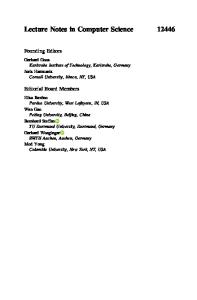Creating New Medical Ontologies for Image Annotation A Case Study
Creating New Medical Ontologies for Image Annotation focuses on the problem of the medical images automatic annotation process, which is solved in an original manner by the authors. All the steps of this process are described in detail with algorithms, ex
- PDF / 2,389,595 Bytes
- 116 Pages / 439.37 x 666.142 pts Page_size
- 14 Downloads / 308 Views
For further volumes: http://www.springer.com/series/10059
Liana Stanescu Dumitru Dan Burdescu Marius Brezovan Cristian Gabriel Mihai l
l
Creating New Medical Ontologies for Image Annotation A Case Study
Liana Stanescu Department of Software Engineering University of Craiova Craiova 200585, Romania [email protected]
Dumitru Dan Burdescu Department of Software Engineering University of Craiova Craiova 200585, Romania [email protected]
Marius Brezovan Department of Software Engineering University of Craiova Craiova 200585, Romania [email protected]
Cristian Gabriel Mihai Department of Software Engineering University of Craiova Craiova 200585, Romania [email protected]
ISSN 2191-8112 e-ISSN 2191-8120 ISBN 978-1-4614-1908-2 e-ISBN 978-1-4614-1909-9 DOI 10.1007/978-1-4614-1909-9 Springer New York Dordrecht Heidelberg London Library of Congress Control Number: 2011943747 # Springer Science+Business Media, LLC 2012
All rights reserved. This work may not be translated or copied in whole or in part without the written permission of the publisher (Springer Science+Business Media, LLC, 233 Spring Street, New York, NY 10013, USA), except for brief excerpts in connection with reviews or scholarly analysis. Use in connection with any form of information storage and retrieval, electronic adaptation, computer software, or by similar or dissimilar methodology now known or hereafter developed is forbidden. The use in this publication of trade names, trademarks, service marks, and similar terms, even if they are not identified as such, is not to be taken as an expression of opinion as to whether or not they are subject to proprietary rights. Printed on acid-free paper Springer is part of Springer Science+Business Media (www.springer.com)
Preface
Advances in medical technology generate huge amounts of nontextual information (e.g., images) along with more familiar textual one. The image is one of the most important tools in medicine since it provides a method for diagnosis, monitoring, and disease management of patients with the advantage of being a very fast noninvasive procedure. As new image acquisition devices are constantly being developed, to increase efficiency and produce more accurate information, and data storage capacity increases, a steady growth of the number of medical images produced can be easily inferred. With such an exponential increase of medical data in digital libraries, it is becoming more and more difficult to execute certain analysis on search and information retrieval-related tasks. Such problems can be tackled by representing the available information using languages such as DAML+OIL and OWL, which benefit from their underlying description logic foundation. Recently, there has been lot of discussion about semantically enriched information systems, especially about using ontologies for modeling data. Ontologies have the potential of modeling information in a way that they can capture the meaning of the content by using expressive knowledge representation f
Data Loading...










